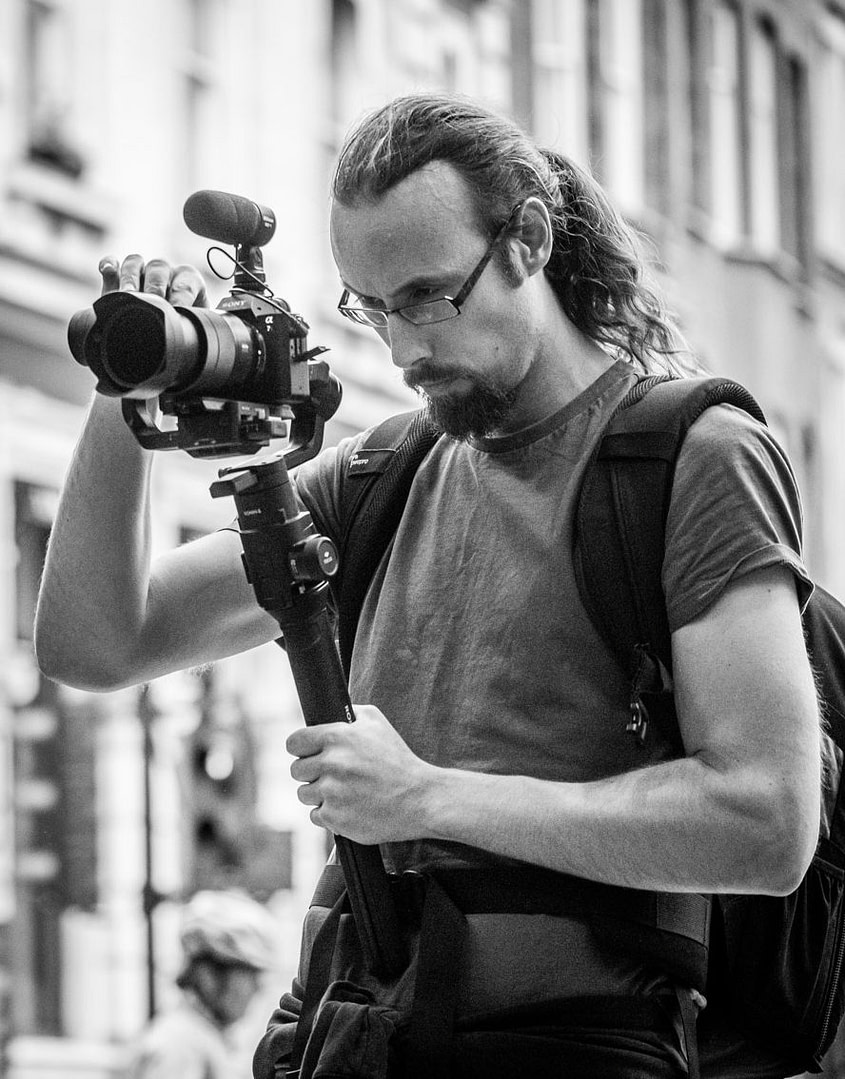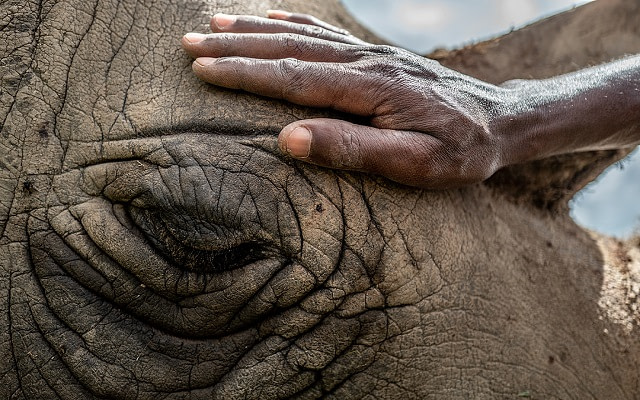Interview with Filmmaker and Photographer Chris Shoebridge

Filmmaker/Photographer: Chris Shoebridge
Interview by: We Animals Media
We Animals Media contributor, Chris Shoebridge, is a self-taught filmmaker and photographer based in the UK and Europe. Originally working with organizations such as the BBC, the National Trust and Swim England, Chris is now focused on animal protection and veganism, producing short documentaries, undercover investigations and promotional films for various campaigns and non-profit organizations. We spoke with Chris to find out what inspires his photo and film projects.
The following footage, now available in our stock collection, documents conditions endured by billions of chickens inside UK factory farms and was secured as part of VFC’s ‘Five Farms‘ series.
Chris Shoebridge (CS): Twelve years ago I was just getting started as a full-time photographer when I saw a short film of the UK’s first slaughter investigation and decided to become vegan. I had a few big commissions at the time, and worked with the BBC, the National Trust, and several other Trusts and National Governing Bodies. I was also involved in activism in my spare time, including collections, marches and demos, helping to set up a vegan festival, and volunteering for a local animal rights group, but it took a couple of years for me to clearly see the overlap between my professional skillset and the objectives of the activism I was already doing. It was a short film which changed my life, and so I already had a sense of the power of visuals in encouraging positive change. From that moment, it was clear where my future lay. Creating powerful and beautiful images that reveal difficult truths and celebrate solutions is the very best way I can contribute to animal protection and a kinder world.
CS: One of the most challenging aspects of my work is turning down good projects I can’t commit to. I want to do everything, to help everyone helping animals in whatever way I can. Learning to say “no” has been difficult, but essential to longevity. Thankfully, I’ve met some incredibly talented vegans over the years that I am proud to recommend when I can’t take on a project. The other challenging part, perhaps unsurprisingly, is dealing with witnessing cruelty. I’ve watched hundreds of hours of slaughter footage while working on investigations, and animals have suffered and died in front of me in factory farms, but if some cruelty or injustice provokes us, I find no alternative than to do something about it.
The best part is knowing that what I’m doing means something. It’s knowing that I’m doing justice to the pig I watched dying alone in a corner of her pen, whose eyes met mine and whose terror will never entirely leave me. It’s knowing that, confronted with the perpetration of industrialised cruelty on an unimaginable scale, I did not close my heart or turn away.
WAM: Your recent ‘Five Farms’ video series with VFC—a UK-based vegan food company—takes celebrities and influencers undercover into UK chicken farms. Why is this an important project?
CS: The ‘Five Farms’ series came about because of an earlier film I produced for VFC, in which Veganuary co-founder Matthew Glover took his VFC co-founder, the chef and restaurateur Adam Lyons, undercover to a British chicken farm. Adam had only just become vegan when we went in, and was only vaguely aware of factory farming, so the experience affected him deeply. The film focuses on Adam’s raw emotional reactions rather than the more abstract moral issue of animal exploitation, an angle which seems to have made it more accessible to a non-vegan audience: if people won’t empathise with chickens, they may at least empathise with Adam. It also has the advantage that Adam can describe the heat and the smell, aspects of the factory farming reality that stills and video cannot adequately communicate. The response to this film was so phenomenal that we knew we had to create an entire series around the concept. Adam has since become absolutely committed as a vegan, and his restaurant in York is now fully vegan, too.
WAM: Is there any particular film you’ve created that you think represents your work and what you’d like to communicate to the world particularly well? Tell us why.
CS: The two films which come closest to representing what I want to say are Invisible, which I produced with We Animals Media and the Unbound Project, and the first VFC film. Both of these short films featured protagonists who provided an intriguing but non-judgmental entry point for a non-vegan audience, yet didn’t flinch from conveying the reality of animal farming. This is what I’m always on the hunt for: how do you encourage non-vegans to examine an industry they may never have thought critically about before?
CS: I don’t tend to have heroes, although I’ve been a fan of Jo-Anne McArthur’s work for years. What she’s accomplished, not just as a photojournalist, but as a human being of indomitable spirit building an organization and carving out an entirely new discipline on behalf of animals, has been quite astounding. There’s inspiration for all of us in that. But ultimately, the people who inspire me the most are those who dedicate themselves to something greater, whether they are photographers and filmmakers or not. In our movement, we are blessed to have these sorts of people in abundance, and it’s almost impossible not to be inspired by those around us.
CS: The process varies considerably depending on what we want the finished product to be, so the first step is always to clearly define the objectives. For investigations, once a site is carefully chosen and scouted, the process is as straightforward as reacting to what we find on the night. For larger studio shoots, I may need to assemble a crew, including scriptwriters, set designers, gaffers, hair and make-up, etc., and I may need to scout locations. For interviews I like to arrive early and build a rapport with the talent, and perhaps tease out some interesting information to bring up while filming. It’s important for one’s confidence going into a shoot to have as much planned as possible, including visualising certain shots that I know I want in the bag, but without being so prescriptive that creativity is stifled. Some of the best moments in filmmaking happen by accident, or in a flash of inspiration part-way through a shoot.
CS: For stills the Nikon D850 is my stalwart. It’s the optimal DSLR for the unusual range of projects I do: of high professional quality for studio work where images will appear on enormous billboards, and robust and resilient enough to be lugged across mud and streams, and over barbed wire fences, to shoot inside hot, humid and dusty factory farms.
For video, I’m currently using a Sony FX6 and a Sony A7sIII combo. The FX6 is a mid-range cinema camera which is outstanding in a studio setting or for event reportage. The A7sIII is only a mirrorless camera, but it has exceptional low light performance and a smaller size which make it ideal for shooting video on investigations, where you need to move quickly and quietly, keep the weight down, and maintain a low profile. The two cameras complement one another perfectly as an A/B pair for interviews, talking heads, TV ads, and all the other promotional content I create for vegan organisations.
CS: Yes, if the objectives allow, I will certainly shoot both, particularly on behalf of groups for whom hiring both a photographer and a filmmaker might not be cost-effective. For certain photojournalistic shoots I will have a D850 slung around my neck while shooting video on an FX6 or A7sIII, so I can quickly swap between the two formats without missing a crucial moment. It’s important to be organised and to have stills and video setups you can rapidly switch between without compromising quality. Sometimes, however, it’s not realistic to perform both functions, and a second shooter is required. One must be honest about what’s possible so that the expectations aren’t greater than your capabilities.
Most of the challenge is in the fact that the two disciplines are different. For people who don’t work in video or photography, it might be a natural assumption that if you can do one you can automatically do the other, which isn’t true despite some transferable skills. But, providing one has the experience in each discipline, and the schedule allows room for a single shooter to meet all the objectives, I can’t think of any other barriers. I’m open to trying challenging things – with adequate planning and prep – and one often discovers that the conventional wisdom about our limitations is false.
CS: Every group – the media, photojournalists, or anyone else – is composed of individuals who each have a distinct and personal set of barriers and possible pathways to animal rights. I suppose I might emphasise that modern neuroscience and ethology point unambiguously to the sentience of most animal species, including all of those we currently farm, and consequently I believe us to be on the cusp of a cultural revolution in our moral consideration of non-human creatures. You can choose to be on the cutting edge of that revolution, to use your talents as communicators to reinforce one of the most important ethical steps forward in human history. What a privilege that would be.
More generally, we seem to have forgotten that we hold the power, whether we are professional communicators or not: that it is entirely up to us what kind of world we want to live in, and that changing the world is as simple as changing our behaviour. I would like to remind people of that. It occurred to me once that to prove irrefutably that there is good in the world, one has only to be good. If anything is worth living by, that is.
CS: As well as some freelance work, I’m also the Director of Video Production over at Million Dollar Vegan, which is where most of my time is currently spent. We have two significant campaigns on the horizon which were pushed back due to the pandemic. I shouldn’t talk about the details just yet, but they both represent enormous opportunities to promote veganism to a new audience – so I’m very excited to help bring these to life. As we enter pre-production on these campaigns, we are continuing our vegan food giveaways to under-served and disadvantaged communities around the world.
I’m also still working on self-funded investigations and plan to continue contributing to We Animals Media, and I am becoming interested in longer-form documentary storytelling too, so perhaps a feature film is in my future. I don’t intend to sketch sharp boundaries, though. There’s so much to be done to confront the problems we are collectively facing that I want to remain open to contributing towards effective solutions, whatever form they might take.
Follow Chris on Instagram: @chrisshoebridgefilm
More like this from We Animals Media:
Interview with Photojournalist Justin Mott
by We Animals Media | July 16, 2021
In The Field: Moving Animals
by We Animals Media | Jan 28, 2021
We Animals Media Welcomes Filmmaker Chris Shoebridge
by We Animals Media | Feb 25, 2020



